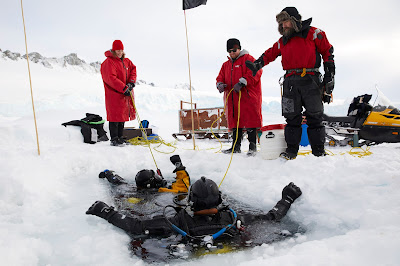Diving Through The Sea Ice
In order to ensure the seasonal monitoring of Antarctic ecosystems and to capture processes happening over winter, the marine team plunged below the sea ice for the first time this month. The sea ice can be a dangerous medium to operate on and therefore great care must be taken when travelling and working on the sea ice. With these considerations in mind, it was hard to supress our excitement as we dressed in looking over our ice hole.
Photo credit- Ed Luke
Testing the sea ice depth is achieved by drilling and measuring the sea ice thickness at 200 m intervals on foot across a travel route. The location of each drill site is recorded with a GPS. The sea ice must be at least 30 cm thick to support a loaded sledge with diving equipment and a skidoo to tow it.
Photo credit- Ed Luke
Photo credit- Ed Luke
The field guides are responsible for ensuring the stability of the ice and had previously drilled depths of 45- 55 cm in August. On a rare low wind and sunny day, a team set foot on the ice accompanied by a skidoo, box trailer and chainsaw. Pete Hill, the boating officer, followed a grid pattern to score the diameter of the ice hole and each individual ice block with the chain saw. Subsequently, an ice screw was placed in the centre of each ice block. Eight enormous ice blocks were systematically removed from each hole to open a primary dive hole as well as an emergency exit hole within 30 m of each other. Human power is used to pull the blocks upwards and out, and are then dragged well clear of the ice hole to avoid drifting snow.
Pete Hill operating the chain saw to cut the primary dive hole
Sam, the carpenter, dressed in an immersion suit ready to help the marine team cut an ice hole.
Photo credit- Nadia Frontier
Removing the ice blocks
Photo credit- Ryan Matthews
A rare, good weather day, Friday 3rd September, marked a momentous occasion for this year’s first ice dive. The marine team assembled the diving gear around the dive hole with Ryan and Pete diving first to collect brittle stars, a bivalve, a nemertean worm and urchins to contribute towards a long-term reproduction study which is maintained by the Marine Assistant. I dived with Jack, one of our diving officers, for our second dive to collect winter samples as part of my seasonal growth study. The diving supervisor, Mike Lindsell, maintained constant communication with the divers using hard-wire communication on 50 m tethers. (See last year's blog for an explanation of diving communication procedures).
Divers enter and egress the water by sliding from the edge of the ice into the water attached to a surface tether. It is a rather thrilling sensation entering through ~60 cm ice walls. Compared to entering the water by rolling off the side of a boat, I felt like a seal sliding into a bath!
Photo credit- Ed Luke
Although the water was not much colder (-1.8 °C) than previous winter dives, being underwater with an overhead platform of sea ice was a new experience. Our eyes had to adjust first to the darkness and once at our dive site, we were constantly aware of a beacon of light penetrating from the ice hole above. Incredibly, seals are attracted to this beacon of light and upon a subsequent ice dive, a Weddell seal came out of the emergency dive hole to rest upon the ice! At the end of the dive, we swim towards our dive hole and I found it really interesting to see the air bubbles produced from our breathing had been held below the ice in pockets - in open water, our bubbles would just diffuse into the atmosphere.
Post-dive
Photo credit- Ed Luke
If ice forms across Ryder Bay to the South, a new dive hole will be cut at a long-term monitoring site to allow the marine assistant to continue water sampling using a Nansen sledge (a type of sledge modelled on traditional Inuit wooden sleds 'qamutiks' designed by an Norwegian Arctic explorer) equipped with an array of hot water bottles. Water freezes quickly in the Niskin bottles (used to sample water at specific depths) and is immediately processed upon return to the laboratory!
In the meantime, ice diving continues with Ryan and I diving twice yesterday. During these dives, we re-deployed the organisms I sampled during our first ice dive. We also conducted a survey of the organisms across a section of the seabed, counting invertebrate life along a transect (achieved by laying a tape measure across a section of habitat). After a total of 55 minutes in the water, we had both never felt so cold! We hope the ice will stay and temperatures will remain low to continue ice diving at one of our key study sties. It's rather special diving below a surface that has encapsulated icebergs.























This comment has been removed by a blog administrator.
ReplyDeleteWow! At last you have been able to dive through the ice. Great photos, would love to see some from underwater if you have any. Thank you for sharing ma fille/Weddel seal ;-)
ReplyDeleteThis comment has been removed by a blog administrator.
ReplyDeleteI am cold for you!! Saw you on BBC. Wonderful. There seem to be so much light below surface. Hard to believe. Carry on the good work. Tks for sharing !
ReplyDeleteHey JY! So nice you watched that, thank you!!! Once your eyes adapt, I was surprised by how much we could see. Hope you are well x
Delete